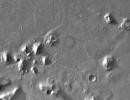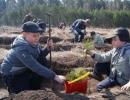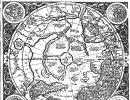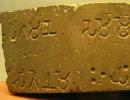Where is the outpost named after Karatsupa on the map. Four karatsups and a dog. Different versions of how Karatsupa was given a Hero
Nikita Fyodorovich Karatsupa(12 (25) April 1910, the village of Alekseevka, Kuibyshevsky district, Zaporozhye region, Ukraine - November 18, 1994, Moscow) - Hero Soviet Union, Colonel of the Border Guard. He is famous for his raids against border trespassers, during which he used well-trained dogs. Wrote the book "Notes of a Pathfinder" about the border service. Called up in October 1932, he served at the Poltavka frontier post of the Red Banner Grodekovsky frontier detachment, in the troops of the Pacific, Eastern, Western, Transcaucasian border districts, in 1957 - 1961. - in the Main Directorate of the Border Troops of the country, helped to establish the border service in Vietnam.
Nikita Karatsupa was born on April 25, 1910 in the village of Alekseevka, now in the Kuibyshevsky district of the Zaporozhye region, in a peasant family. He did not remember his father, who died when the son was small. In 1913 he moved to Kazakhstan with his mother and lived in Atbasar. At the age of 7 he remained an orphan, was brought up in the Shchuchinsky orphanage of the Kokchetav region. After being drafted, he graduated from the Far Eastern District School of Junior Officers of Service Dog Breeding, and in 1937 - training courses for officers at the Central School of Service Dog Breeding of the Border Troops.
Biography
He learned the basics of service dog breeding and the basics of border skills at the Khabarovsk school-kennel for service dogs in 1933. There were not enough purebred dogs for all cadets, so the Red Army soldier Karatsupa was allowed to train the half-breed Ingus. These names will subsequently be worn by all his four-legged friends. For half a year, Karatsupa raised an excellent service dog from a puppy and learned how to skillfully conduct martial arts with border violators.
In the book Notes of a Pathfinder, Karatsupa devoted an entire chapter to an internship at the Verkhne-Blagoveshchenskaya border outpost. In those years, Soviet Blagoveshchensk and Manchu Sakhalyan (now Heihe) were one of the areas of active smuggling. The Chinese city located opposite our regional center was not only a concentration point for White Guards and smugglers of all stripes, but also a center of Japanese espionage. There were many violations of the border in this area.
Karatsupa, among five cadets, arrived there for an internship. At first, he did not impress the head of the outpost, but his majesty chance put everything in its place.
When hope was lost to detain the violator of the border, the head of the outpost remembered the last reserve - the guide of the service dog Nikita Karatsupa, and he and Ingus literally performed a miracle. A dog found a trail in the trampled area, and after a long pursuit, the young border guard, along with his shaggy friend, detained a dangerous intruder.
After completing the internship, Karatsupa did not stay long at the service dog school. He passed his exams with flying colours, and was assigned to the Poltavka outpost.
Strong-willed, fearless, resourceful, the border guard Karatsupa detected violators, despite their most intricate tricks. In the external slowness of his movements lurked the ability to instantly react at the moment of meeting with the enemy. He could run 30 - 50 or more kilometers through the most difficult terrain, in rain, cold, snowstorm and, neglecting the danger, with very modest equipment for today - a carbine, a Mauser and a faithful assistant in military affairs, shaggy Ingus, to engage in a fight and detain armed to the teeth of border trespassers.
Karatsupa received all-Union fame in 1936 after he was awarded the first Order of the Red Banner. Boys all over the country played “Karatsupa”, and when they grew up, they became “green caps”. And their idol continued to increase the battle score.
Once, with the faithful Ingus, he detained a whole gang of violators. And it was like that.
In the moonlight, Karatsupa saw people walking across the field. Counted. Nine. And yet I decided to stop. He lay down and, when only a few meters remained to the violators, he dumbfounded them with a loud: “Stop! Hands up!"
They lay down. And Karatsupa began to command loudly: “Zaiganov, Kharlamov! Go around on both sides of four people. Whoever runs, shoot without warning. I will check them."
The perpetrators stood up and raised their hands. Karatsupa took away the weapons, built them into a column of two and led them to the outpost, occasionally giving orders to "fighters Zaiganov and Kharlamov." The bandits looked around frantically. The moon peeked out from behind the clouds, and they saw that the border guard was alone. Someone drew a pistol, but Ingus with a swift jump knocked the intruder off his feet. In those moments, reinforcement arrived ...
For 20 years of service on the border, Karatsupa participated in 120 armed clashes with enemies, detained 338 border violators, destroyed 129 spies and saboteurs who did not lay down their arms. Over the decades, the legendary border guard, according to various sources, has trained from 800 to 1000 trackers. Since 1961, Colonel Karatsupa has been in reserve. Lived in Moscow, worked at the Central Museum of the Border Troops.
He was buried in Moscow at the Troekurovsky cemetery.
Awards
The title of Hero of the Soviet Union with the award of the Order of Lenin and the medal " Golden Star”(No. 10705) Colonel of the Reserve Karatsupa Nikita Fedorovich was awarded by the Decree of the Presidium of the Supreme Soviet of the USSR of June 21, 1965 for the exemplary performance of the tasks of the command to protect the State Border of the USSR and the courage and heroism shown at the same time.
- The order of Lenin
- 2 Orders of the Red Banner
- Order of the Red Star
- Medals
Schools, libraries, river boats, border outposts in Vietnam and India are named after Karatsupa. By order of the head of the troops of the Red Banner Pacific Border District, Nikita Karatsupa was enrolled as an honorary border guard of the outpost, where he carried out a combat watch for the first ten years of his service.
The study of his memoirs and publications about the experience of the legendary border guard provides rich material for comprehending border skills, educating and training the current guards of the borders of Russia.
How an orphan from Ukraine became a legend of the border troops
Even Indian hunters would envy the skills of the Soviet border guard. The history of border protection knows many names that have become legendary. The border service is such that there is no peacetime in it - at any moment one must be ready for a criminal encroachment on the part of smugglers, saboteurs, and armed gangs. Even the calmest sections of the border are only relatively calm - the slightest relaxation allowed by the border guards can lead to serious consequences. But even in the long list of border guard heroes, there is a name that stands out especially.
Kazakh bai shepherd. This man not only received the unofficial title of “grandfather of all border guards” during his lifetime, but also stood on a par with the epic heroes who once also guarded the borders of Russia.
When a boy named Nikita was born in a simple peasant family of Fyodor Karatsupa, who lived in the Ukrainian village of Alekseevka, on April 12, 1910, nothing indicated that an extraordinary future awaited the baby.
Moreover, life did not indulge little Nikitka. Shortly after his birth, his father died. Mother, Marfa Kuzminichna, moved to Kazakhstan in 1913 with three children in search of a better life.
Nikita was six when her mother passed away. The older brother and sister did not deal with the fate of Nikita. Thekla went to work and got married, providing younger brother to myself. Grigory left for Ukraine, where he joined the Makhnovists during the Civil War and was killed in one of the battles.

Nikita Karatsupa - the border guard from the legend
The young Nikita was sent to an orphanage, where, however, he did not stay long - he ran away and began to wander. During the period civil war there were hundreds of thousands like him. Nikita could die at any moment, but fate seemed to protect him.
At the age of 9, the boy got a job at one of the Kazakh bais and began to graze a flock of sheep. A shepherd cannot do without such an assistant as a dog, and Nikita also got one. The dog's name was Buddy.
Here, for the first time, the innate talent of Nikita Karatsupa woke up. The boy managed to train an unprepared dog so that she could independently graze a flock of sheep, protecting them from wolves.

Border guards at work
Invisible border guard. During the Civil War, the shepherd Nikita was a liaison in the partisan detachment of the "Reds" and in this role managed to annoy the Kolchak people a lot, who could not catch the clever boy.
After the Civil War, Nikita Karatsupa tried several professions, but did not find himself in them. Everything changed when one day a border guard guarding the border in Karelia arrived in the village where Nikita lived. From his story, the young guy learned about the border service and how dogs are used in it.
Nikita decided to become a border guard. However, when in 1932 he was drafted into the army, the impulse of the former shepherd was not appreciated in the military registration and enlistment office. “Small for a border guard,” they told him. The low Karatsupa immediately retorted: "Nothing, the low border guard and the violator will not notice."

Training of service dog instructors at the site of the 59th Khasansky border detachment, 1939, Karatsupa - on the left
Taken aback, employees of the military registration and enlistment office sent the conscript to the border troops. After completing a course of initial training, he was sent to the border with Manchuria. In the Far East at that time it was restless - in 1930-1931 alone, border guards detained 15,000 violators.
Private Karatsupa attracted the attention of the head of the outpost. The guy was an excellent tracker, he was well versed in the tracks of people and animals, he could determine who, when and in what direction passed. In addition, Nikita was excellent at finding mutual language with horses and dogs.
At the suggestion of the head of the outpost, Private Karatsupa was sent for further training to the Far Eastern District School of the junior command staff of the service dog breeding of the border and internal guards of the NKVD.

Nikita Karatsupa guarding the state border, 1955
Hindu from under the bridge. The training began with embarrassment - Karatsupa did not get a dog at school, because he arrived later than the training course began. This, however, did not bother the young border guard. One day he found two small stray puppies under the bridge. Out of purebred mongrels, whom he called Indus and Irgus, Karatsupa raised service-search dogs. Irgus Nikita handed over to another cadet, and the border guard kept the more lively Hindu.
The Hindu would not have passed a single modern exhibition - he was a simple mongrel without a pedigree, but among his ancestors there were clearly East European shepherd dogs. Karatsupa was not mistaken - the dog turned out to be extremely talented and intelligent, with an extremely high capacity for work.
Indus and Karatsupa detained their first violators while still practicing at the dog breeding school. In the same place, a young border guard was attracted to the search for a brutal serial killer. Karatsupa with his dog followed the trail for several tens of kilometers and nevertheless overtook the criminal, who did not want to give up and was destroyed.

Nikita Karatsupa and his faithful Hindu
When the guide of the service dog Karatsupa arrived at the Poltavka outpost of the Grodekovsky border detachment after graduation, they looked at him with skepticism. The attitude towards newcomers is always wary, and the exploits of the border guard at the school were considered exaggerated.
However, skepticism dissipated very quickly, because Karatsupa and the Hindu showed themselves in all their glory. During the first three years of service, 131 detained violators were on their account.
Universal Soldier. Karatsupa himself not only possessed an amazing capacity for work, but also constantly developed his skills. For example, he distinguished about 240 different smells. He constantly systematized and generalized his observations related to official tracking. Subsequently on scientific base created by Karatsupa, the next generations of border guards will be trained.

One of the Hindus of Nikita Karatsupa
Nikita Karatsupa is known primarily as an instructor of service dog breeding, but he often had to detain violators without the help of a dog. This was helped by constant training in shooting and hand-to-hand combat.
In addition, Karatsupa constantly trained long-distance running in order to move in the same rhythm with the dog following the trail. It happened that the border guard threw off his cap, overcoat, boots and light, with one "Mauser", continued to follow the dog.
Service dog instructor Karatsupa seemed to know and be able to do everything. Once he figured out the saboteurs who were preparing to undermine the bridge, just one detail. The criminals, disguised as fishermen, put the worm on the hook incorrectly, which did not escape the attention of the avid fisherman Karatsupa. As a result, the saboteurs were detained.

Effigy of the last Hindu Nikita Karatsupa in the Museum of the Border Troops in Moscow
Colleagues simply could not keep up with Karatsupa and his dogs, so very often the border guard detained violators only with the dog. He was not afraid of either the armament of the opponents or their numbers. Once Nikita Karatsupa independently detained a gang of drug couriers, which included nine people.
From Manchuria to Vietnam. There were legends about the glory of Karatsupa in the Far East. Once, while pursuing an intruder, the border guard stopped the car in order to catch up with the saboteur who had fled on a "ride". The stopped truck had to be unloaded from food so that it could catch up with the car in which the criminal left.
On the bags left on the ground, the border guard put a note: “Whoever dares to take even a gram will be found and severely punished. Border guard Karatsupa and the Hindu dog. As a result, the offender was detained, and no one touched the cargo with a finger - such was the authority of Nikita Fedorovich among the local population.

Hero of the Soviet Union border guard Nikita Karatsupa. Photo source: P. Bernstein, RIA Novosti
It is impossible to cover the entire biography of the border guard-pathfinder in one article. He spent most of his service in the Far East, but in 1944 he was transferred to Belarus, where he restored the border and fought Nazi accomplices. There was a completely unique page in the life of Karatsupa - in 1957 he went on a business trip to Vietnam, where he helped create local border troops virtually from scratch.
Nikita Fedorovich Karatsupa entered the reserve in 1961 with a relatively modest rank of colonel. At the same time, his general track record is as follows: 338 detained violators, participation in 120 clashes with saboteurs and criminals, in which Nikita Karatsupa personally destroyed 127 opponents who offered armed resistance.
The saboteurs were on a real hunt for Karatsupa himself, trying to destroy the legendary border guard. Nikita Fedorovich was wounded three times, and faithful dogs saved him from death more than once. During their service, Karatsupa had five, all of them, in honor of the very first dog, were called Hindus, and they all died in battles with saboteurs.

In the homeland of Nikita Fedorovich in Ukraine, a memorial sign was erected in honor of the 100th anniversary of the famous border guard
The last wounded Hindu Karatsupa, then already known throughout the country, was taken to Moscow to the best veterinarians. However, they could not save the dog. The fifth Hindu is now in the Museum of the Border Troops - taxidermists made a stuffed animal from a dead dog at the personal request of Nikita Fedorovich.
Dog alias. Nikita Fedorovich Karatsupa before recent years During his life he worked at the Museum of the Border Troops, helped in training young people, created a large theoretical base and methodology for training service dogs.
Karatsupa was a unique specialist who literally knew all the secrets of a dog's soul. For example, he knew how to give commands to dogs ... on the phone. And formidable watchdogs, hearing the voice from the handset, obeyed implicitly.
An interesting point - for a long time in books and articles about Karatsup, his dogs appeared under "pseudonyms" - not "Indus", but "Ingus". Someone very cautious was afraid of international complications - they say, the dog's nickname "Hindu" can offend our friendly Indians.

The grave of the legendary border guard at the Troekurovsky cemetery in Moscow
Apparently, the Indians were not offended - one of the border outposts in India bears the name of Nikita Karatsupa, whose fame has reached those distant places. The same outpost exists in Vietnam, where they appreciated the help of the legendary Soviet border guard, provided in the creation of a border service in the country. In 1995, after the death of Nikita Karatsupa, the outpost where he began his brilliant career, Poltavka, received his name.
... During his life, Nikita Fedorovich Karatsupa received many awards, but he was awarded the highest after he retired. On June 21, 1965, he was awarded the title of Hero of the Soviet Union with the Order of Lenin and the Gold Star medal ...
Andrey SIDORCHIK, "Arguments and Facts"
On April 25, the famous border guard, Hero of the Soviet Union, Colonel Nikita Fedorovich Karatsupa would have turned 100 years old. For 20 years of service on the Far Eastern border, he, along with his shepherd dog Ingus, detained 338 violators, destroyed 129 spies and saboteurs, with honor coming out of 120 combat clashes. He trained about a thousand trackers, and the experience he gained in service dog breeding is in demand at the present time.
After graduating from school, Karatsupa, together with his "pupil", begins service on the border in Primorye, at the Poltavka outpost of the Grodekovsky detachment. It was on this site that he made most of the arrests. As Karatsupa himself recalls, once he had to run 40 km from the border in order to catch a criminal. It was possible to overtake the intruder only in Ussuriysk at a local cinema. According to the border guard, he recognized the criminal by the cap, according to kmslib.ru.
Hero "Komsomolskaya Pravda"
In 1936, Karatsupa was awarded the Order of the Red Star. At the same time, journalists from Komsomolskaya Pravda arrived in Primorye to collect interesting information about the order bearers. It was thanks to the essays of one of the correspondents, Yevgeny Ryabchikov, that Karatsupa received all-Union fame and recognition. He became a folk hero for everyone, from yard boys and young guys seeking to join the ranks of the border guards, to outstanding military figures.
After Far East Nikita Fedorovich served in the troops of the Western, Transcaucasian border districts. From 1957 to 1961 Karatsupa served in Moscow in the Main Directorate of the Border Troops. Interestingly, when in the mid-1950s. friendly relations were established with India, for ethical reasons, in new publications about Karatsup, Hindu was replaced by Ingus. The famous border guard had several service dogs under this name, all of them died in battles with saboteurs. When the first Ingus died, Nikita Fedorovich buried him, indicated the date of birth, but did not set the date of death. “Ingus didn’t die for me, he remained forever in my heart,” said the border guard.
In 1961, Karatsupa retired from the reserve, and in June 1965 he was awarded the title of Hero of the Soviet Union. About his service and rich experience, Nikita Fedorovich wrote the book "Notes of a Pathfinder", the life of the legendary border guard was also filmed. documentary"Pathfinder". Nikita Fedorovich Karatsupa died in November 1994.
There are 76 bronze sculptures in the niches of the hall in the Moscow metro at the Ploshchad Revolyutsii station. Sculptor Matvey Manizer created images Soviet people, but the most famous of them, perhaps, is a border guard with a dog. According to the prevailing sign (coming from Bauman students), passers-by rub the dog's nose - for good luck - but hardly anyone guesses who is hiding behind this figure.
In the late 1930s, when these sculptures were being created, newspapers wrote a lot about the famous border guard Nikita Karatsup and his dog Hindu. Photos of the border guard with his faithful dog inspired the sculptor Manizer and served as prototypes for his sculptural heroes.
The fate of the legendary border guard was not easy. Nikita Karatsupa was born into a peasant family in the village of Alekseevka, Zaporozhye region. His father died early, and his mother and children went to work in Turkestan. But when Nikita was seven years old, his mother also died, and the boy ended up in an orphanage. However, the boy, with an independent and freedom-loving character, soon ran away from him and went to work as a shepherd to the local bay. It was here, surrounded by dogs, that Nikita learned to find a common language with them and mastered the skills of training. His first pet Druzhok, under the guidance of his young master, showed extraordinary abilities, guarding the herd from wolves, which caused general amazement.

It was at this time that Nikita Karatsupa learned to recognize the traces of people and animals, to distinguish the smallest shades of smells. These skills were later useful to him in the service (he was able to distinguish 240 smells).
In 1932, when it was time to go to the army, Nikita Karatsupa, having appeared at the military registration and enlistment office, expressed a desire to serve on the border. At first he was denied this - he was small in stature - but the young man persisted, saying that it would be more difficult for violators to notice him.
And Nikita was sent to the Manchurian border. Noticing his ability to skillfully handle dogs, the leadership assigned him to the NKVD school, located in Khabarovsk, where guard dogs were trained. As Nikita Fedorovich himself later recalled, he arrived at school late, so he did not get a puppy for training. However, not at a loss, he found two homeless mongrels on the street, similar to East European Shepherd Dogs, and took them into his upbringing. When the dogs grew up, he kept one for himself, and gave the other to a fellow cadet.
Nikita Karatsupa named his dog Hindu. Subsequently, all his dogs bore this nickname (there were five of them), and only in the fifties, when the Soviet Union began to improve relations with India, he was asked to change his nickname to Ingus.
While studying at the service dog training school, Nikita learned to shoot accurately, mastered the techniques of hand-to-hand combat, and also developed the ability to run long distances. He could run 50 km at the same pace as a dog. He took off his boots, overcoat and cap, pursuing border violators. In these cases, Karatsupa single-handedly entered into battle with them, since his colleagues did not keep up with him.
Once Karatsupa and Hindu together managed to detain nine armed offenders. Nikita Fedorovich showed ingenuity. Being in the dark, he gave orders to the border guards who were allegedly next to him, creating the impression that a whole detachment was involved in the detention. This incident thundered throughout the country and brought Karatsupa national fame.
In total, during the years of service, Karatsupa detained 338 border violators and destroyed 129 spies and saboteurs who did not want to surrender. He himself was wounded three times.
All his dogs did not live to old age, they died at the hands of bandits at a military post. Karatsupa brought his last dog, seriously injured, to Moscow and tried to cure it, but the veterinarians could not save it. A stuffed animal of this dog, made at the request of Nikita Fedorovich himself, is now in the museum of the border guards.
 The famous border guard Nikita Karatsupa (Hero of the Soviet Union, colonel of the border service) lived for a long time - until 1994. Even during his lifetime, many monuments were erected to him - and not only in the subway. For example, the plaster monument "Defender of the Far Eastern Frontiers" (Karatsupa with a dog) was located on the roof of the Rodina cinema on Semyonovskaya Square, where a summer cafe worked at that time. When the cafe was closed, the sculpture was lost.
The famous border guard Nikita Karatsupa (Hero of the Soviet Union, colonel of the border service) lived for a long time - until 1994. Even during his lifetime, many monuments were erected to him - and not only in the subway. For example, the plaster monument "Defender of the Far Eastern Frontiers" (Karatsupa with a dog) was located on the roof of the Rodina cinema on Semyonovskaya Square, where a summer cafe worked at that time. When the cafe was closed, the sculpture was lost.
And after the death of Nikita Fedorovich (at the age of 84), a monument was erected to him in Terletsky Park. The author of the monument is Salavat Shcherbakov.
25.04.1910 - 18.11.1994
The hero of the USSR
| monuments | |
Karatsupa Nikita Fedorovich - Colonel of the Reserve of the Border Troops of the Committee state security under the Council of Ministers of the USSR.
Born on April 25, 1910 in the village of Alekseyevka, Berdyansk district, Tauride province, now Belmak district, Zaporozhye region of Ukraine, into a peasant family. Ukrainian. Member of the CPSU (b) / CPSU since 1941. In 1913, together with his mother (he did not remember his father, who died very early), he moved to the Akmola region of the Steppe Governor General, lived in Atbasar. At the age of seven, he remained an orphan, was brought up in the Shchuchinsky orphanage of the Kokchetav (now Akmola) region.
He was drafted into the border troops in October 1932. In 1933 he graduated from the Far Eastern District School for the Junior Commanding Staff of Service Dog Breeding, in 1937 - training courses for command staff at the Central School of Service Dog Breeding of the Border Troops. He served as a guide and instructor of the dog service at the Poltavka frontier post of the Grodekovsky Red Banner Border Detachment, in various positions in the troops of the Pacific, Eastern, Western, Transcaucasian border districts. In 1957-1961 he worked in the Main Directorate of the Border Troops of the State Security Committee (KGB) under the Council of Ministers of the USSR, helped to establish the border service in the Democratic Republic of Vietnam.
Possessing rare strong-willed qualities, fearless, resourceful, he detected violators despite their most intricate tricks. In the external slowness of movements, the ability of the border guard to instantly react in the acute moment of meeting with the enemy lurked. He could run thirty, fifty - as many kilometers as needed through the most difficult terrain, in rain and cold, in snowstorms and snowstorms, and, neglecting the danger, engage in battle, detain border violators armed to the teeth. Even with a very modest outfit for today - a horse, a dragoon, a Mauser, a faithful shaggy assistant in military affairs Ingus - Karatsupa succeeded in everything.
For 20 years of service on the border, Karatsupa participated in 120 clashes with enemies, detained 338 border violators alive, destroyed 129 spies and saboteurs who did not lay down their arms.
Since 1961, Colonel N.F. Karatsupa - in stock.
By the Decree of the Presidium of the Supreme Soviet of the USSR of June 21, 1965 for the exemplary performance of the tasks of the command for the protection of the State Border of the USSR and the courage and heroism shown at the same time to the reserve colonel Karatsupe Nikita Fedorovich He was awarded the title of Hero of the Soviet Union with the Order of Lenin and the Gold Star medal.
The last years he lived in the city of Moscow. He worked at the Central Museum of the Border Troops. Died November 18, 1994. He was buried at the Troekurovsky cemetery in Moscow (plot 3).
He was awarded the Order of Lenin (06/21/1965), 2 Orders of the Red Banner (including 02/14/1936), the Order of the Red Star, medals.
Schools, libraries, river boats, border outposts, including those in Vietnam and India, are named after Karatsupa. The name of the Hero was given to the frontier post "Poltavka" (1995). By order of the Chief of the Troops of the Red Banner Pacific Border District, Karatsupa was enrolled as an honorary border guard of this outpost, where he constantly kept a combat watch for the first ten years of his border service. A bust of the Hero was erected in his native village.
|
Biography provided |






